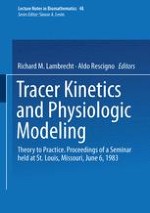1983 | Buch
Tracer Kinetics and Physiologic Modeling
Theory to Practice. Proceedings of a Seminar held at St. Louis, Missouri, June 6, 1983
herausgegeben von: R. M. Lambrecht, A. Rescigno
Verlag: Springer Berlin Heidelberg
Buchreihe : Lecture Notes in Biomathematics
Enthalten in: Professional Book Archive
